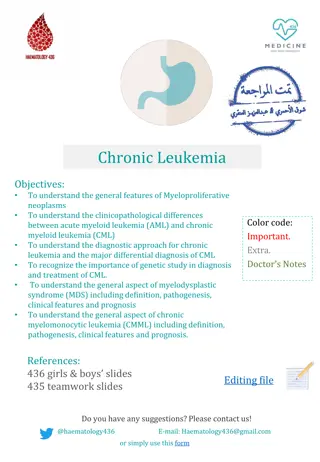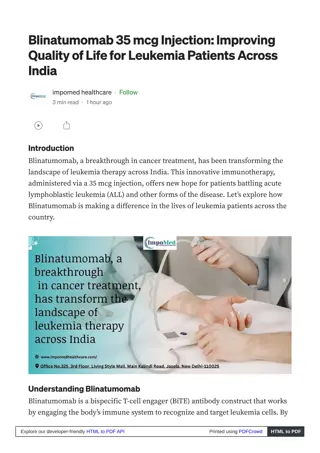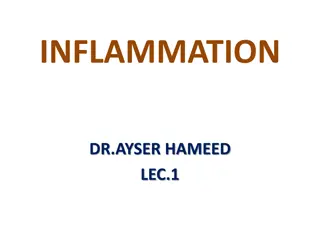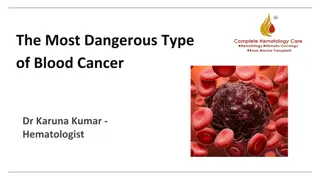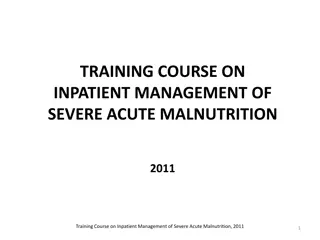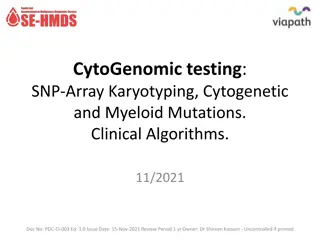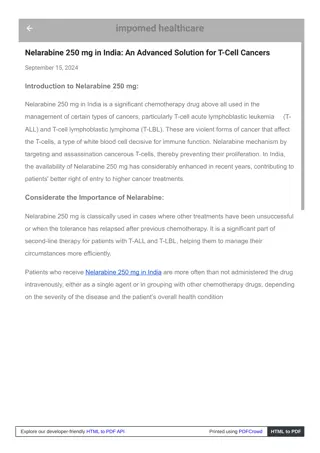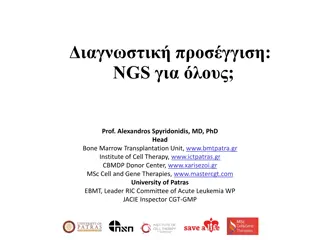Acute Myeloid Leukemia
Acute myeloid leukemia (AML) is a type of cancer characterized by the rapid growth of abnormal white blood cells. This leads to bone marrow failure, organ infiltration, and various symptoms. Learn about the classification, diagnosis, and analysis methods for AML.
Download Presentation

Please find below an Image/Link to download the presentation.
The content on the website is provided AS IS for your information and personal use only. It may not be sold, licensed, or shared on other websites without obtaining consent from the author.If you encounter any issues during the download, it is possible that the publisher has removed the file from their server.
You are allowed to download the files provided on this website for personal or commercial use, subject to the condition that they are used lawfully. All files are the property of their respective owners.
The content on the website is provided AS IS for your information and personal use only. It may not be sold, licensed, or shared on other websites without obtaining consent from the author.
E N D
Presentation Transcript
Acute myeloid leukaemia Ass.Prof.Abeer Anwer Ahmed
The leukaemias are a group of disorders characterized by the accumulation of malignant white cells in the bone marrow and blood. These abnormal cells cause symptoms because of: (i) bone marrow failure (e.g. anaemia, neutropenia, thrombocytopenia); and (ii) infiltration of organs (e.g. liver, spleen, lymph nodes, meninges, brain, skin or testes).
Classification of leukaemia The main classification is into four types: acute and chronic leukaemias, which are further subdivided into lymphoid or myeloid. Acute leukaemias are usually aggressive diseases in which malignant transformation occurs in the haemopoietic stem cell or early progenitors. Genetic damage is believed to involve several key biochemical steps resulting in: (i) an increased rate of proliferation, (ii) reduced apoptosis and (iii) a block in cellular differentiation. these events cause accumulation in the bone marrow of early haemopoietic cells known as blast cells. The dominant clinical feature of acute leukaemia is usually bone marrow failure caused by accumulation of blast cells, although organ infiltration also occurs. If untreated, acute leukaemias are usually rapidly fatal, although with modern treatments most younger patients are ultimately cured of their disease
Diagnosis of acute leukaemia Acute leukaemia is normally defined as the presence of over 20% of blast cells in the bone marrow at clinical presentation. However, it can be diagnosed with less than 20% blasts if specific leukaemia associated cytogenetic or molecular genetic abnormalities are present The lineage of the blast cells is defined by microscopic examination (morphology) Immunophenotypic (flow cytometry) ,cytogenetic and molecular analysis
Immunophenotypic analysis define whether the blasts are of myeloid or lymphoid lineage and also localize the stage of cellular differentiation The typical myeloid immunophenotype is CD13, CD33+ and TdT . Special antibodies are helpful in the diagnosis of the rare undifferentiated, erythroid or megakaryoblastic subtypes
Cytogenetic and molecular analysis is essential and is usually performed on marrow cells, although blood may be used if the blast cell count is particularly high. Cytochemistry can be useful in determining the blast cell lineage. but is no longer performed in centres where the newer and more definitive tests are available.
Acute myeloid leukaemia Pathogenesis The AML genome contains an average of about 10 mutations within protein coding genes, amongst the smallest number of any adult cancer . Many AML driver mutations have been identified, with the most common being within FLT3, NPM1 and DNMT3A . Some other mutations, e.g. of ASXL1, are frequent in myelodysplasia and when found in AML suggest that it is secondary to myelodysplasia. The mutations usually occur on only one of the two alleles for the gene and may be loss of function or gain of function . The average AML at presentation contains less than one gene fusion event, which usually arise from translocations, with the most common being PML RARA, CBFB MYH11, RUNX1- RUNX1T1 which are found in around 15%, 12% and 8% of cases respectively. The wide variety of cytogenetic abnormalities and molecular mutations are such that each case usually has a unique pattern of mutations.
Incidence Acute myeloid leukaemia (AML) is the most common form of acute leukaemia in adults and becomes increasingly common with age, with a median onset of 65 years. It forms only a minor fraction (10 15%) of the leukaemias in childhood. Cytogenetic abnormalities and response to initial treatment have a major influence on prognosis
AML is classified according to the World Health Organization (2008) scheme. There is an increasing focus on the genetics abnormalities within the malignant cells and it is likely that ultimately almost all AML cases will be classified by specific genetic subtype. Currently this is not possible but many genetic subtypes have been determined. Approximately 60% of tumours exhibit karyotypic abnormalities on cytogenetic analysis and many cases with a normal karyotype carry mutations in genes such as nucleophosmin FLT3, (NPM1), CEBPA, DNMT3A detected only by molecular methods and which have prognostic significance
Six main groups of AML are recognized 1 AML with recurrent genetic abnormalities encompasses subtypes with specific chromosomal translocations or gene mutations. The detection of these abnormalities defines the tumour as AML and so the diagnostic criteria for this subgroup are relaxed in that the bone marrow blast cell count does not need to exceed 20% in order to make a diagnosis. In general these disorders have a good prognosis. 2 AML with myelodysplasia related changes. In this group the AML is associated with microscopic features of dysplasia in at least 50% of cells in at least two lineages. The clinical outcome of these patients is impaired in relation to the first subgroup.
3 Therapyrelated myeloid neoplasms(tAML) arise in patients who have been previously treated with drugs such as etoposide or alkylating agents. They commonly exhibit mutations in the MLL gene and the clinical response is usually poor. 4 AML, not otherwise specified. This group is defined by the absence of cytogenetic abnormalities and comprises around 30% of all cases. Mutations in the NPM1and FLT3 genes are more frequent in those with normal cytogenetics
5 Myeloid sarcoma is rare but refers to a disease that resembles a solid tumour but is composed of myeloid blast cells 6 Myeloid proliferations related to Down s syndrome. Children with Down s syndrome have a greatly increased risk of acute leukaemia. Two myeloid variants are recognized: (i) transient abnormal myelopoiesis in which there is a selflimiting leucocytosis; and (ii) AML.
Mixed phenotype acute leukaemia These rare cases express two markers for both myeloid and lymphoid differentiation either on the same blast cells or on two different cell populations. They usually have a poorprognosis.
Clinical features The clinical features of AML are dominated by the pattern of bone marrow failure caused by the accumulation of malignant Infections are frequent, and anaemia and thrombocytopenia are often profound. A bleeding tendency caused by thrombocytopenia and disseminated intravascular coagulation (DIC) is characteristic of the promyelocytic variant of AML. Tumour cells can infiltrate a variety of tissues. Gum hypertrophy and infiltration ,skin involvement and CNS disease are characteristic of the myelomonocytic and monocytic subtypes
Investigations Haematological investigations reveal a normochromic normocytic anaemia with thrombocytopenia in most cases. The total white cell count is usually increased and blood film examination typically shows a variable numbers of blast cells. The bone marrow is hypercellular and typically contains many leukaemic blasts . Blast cells are characterized by morphology, immunological (flow cytometric) cytogenetic and molecular genetic determining prognosis and developing a treatment plan analysis for confirming the diagnosis,
Cytochemistry is no longer used in most centres. Tests for DIC are often positive in patients with the promyelocytic variant of AML . Biochemical tests are performed as a baseline before treatment begins and may reveal raised uric acid or lactate dehydrogenase.
Cytogenetics and molecular genetics Two of the most common t(8;21) and inv(16) are associated with a good prognosis. Acute promyelocytic leukaemia is a variant of AML that contains the t(15;17) translocation in which the gene PML on chromosome 15 is fused to the retinoic acid receptor gene, RAR , on chromosome 17 . The resultant PML RAR fusion protein functions as a transcriptional repressor whereas normal (wild type) RAR is an activator. Normally, the PMLprotein forms homodimers with itself, whereas the RAR protein forms heterodimers with the retinoid X receptor protein, RXR. The PML RAR fusion protein binds to PML and RXR, preventing them from linking with their natural partners. This results in the cellular phenotype of arrested differentiation.
Point mutations affecting the genes FLT3, NPM1, DNMT3A, CEBPA, TET2, WT1, IDH1, RUNX1, and others are frequent in AML, especially in those cases without a cytogenetic abnormality . They may be used to subclassify the disease and have prognostic significance . Some of these genes are involved in DNA methylation or acetylation and are also mutated in cases of myelodysplasia and myeloproliferative diseases . The presence in de novo AML of a myelodyplasia specific mutation, e.g. of ASXL1 or SF3B1 is unfavourable.



